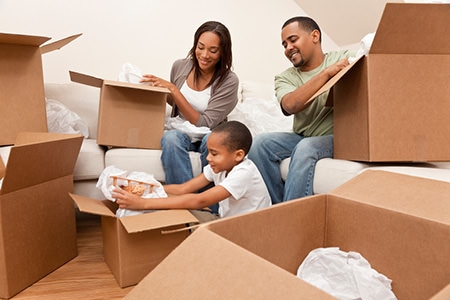
By Relocation.com
When moving to a new house, packing electronics require more attention compared to, say, your furniture. Electronic appliances need careful packing as they are fragile. They are also sensitive to dust, moisture, magnetic fields, pressure and vibrations. Pack them well to ensure you still get to use them (and they remain in tiptop condition) in your new home. Here are some of our tips:
Pack sets together. Some electronic equipment, for example stereo components and movie theater systems, come in sets. Make sure that you pack the sets together. If you accidentally misplace a part, you might be left with a hi-fi system that’s missing one speaker. You should also pack all the corresponding wires and peripherals together with the main system to save yourself the trouble of sorting them out again later.
Use moving boxes for storage. If you haven’t disposed of them yet, use the original moving boxes and paddings, otherwise sturdy corrugated carton boxes bought from the store or provided by the mover will serve the purpose.
Draw a diagram of the wiring. For reference in re-connecting wires and cables between components, draw a diagram of how the wires are hooked up to their corresponding terminals on the device. Note down the color coding scheme or attach matching tags to each wire-terminal pair. Bundle wires and cables securely and label them but do not bind or roll them too tightly to avoid internal damage. Optical fiber cables can easily break.
Secure loose/moving parts with masking tape. If you have a vinyl record player, disconnect the stylus assembly from the tone arm, put it in a small box and tape the box under the tone arm. Fix the turntable to the base with tape to prevent its movement and tape the tone arm to its rest. Lastly close the turntable cover and tape it to the base. Put small hardware items such as screws, nuts and bolts inside a plastic bag and tape the bag to the component where they came from.
Always label “FRAGILE, ELECTRONICS” on the sides and top of each box. When necessary put a “THIS SIDE UP” label on the sides of the box. It goes without saying that cargo items should be tagged with the name and address of the owner.
Before and during the move, keep components away from sources of liquids, wet surfaces, and strong magnetic fields. Provide water-damage protection by placing components inside plastic bags before packing them in boxes.
Pack to protect fragile parts. For components subject to risk of breakage or scratches like TV screens or computer monitors, pack them in such a way as to minimize stress or pressure to the delicate parts. Provide appropriate padding or spacers such as thick cardboard or styrofoam boards or pellets.
Cover speakers. Speaker units also need to be protected from possible dents to the cabinet and the acoustic cones. Cover the front of the cabinet with cardboard and wrap it over and around the edges. For heavy units, it’s a good idea to bind the box with packing tape to prevent bursting and tie it with heavy cord to provide handles for lifting.
Make sure the moving service company drives with care! Check whether the moving company has insurance coverage against loss or damage to cargo.

These tips will make your miliary move easier
By Dermound Becker
Special to Relocation.com
In general, families in the military move from one base to another – and even from country to country – about once every two years on average. Since moving is such a great upheaval it can be especially difficult for military families to cope and manage with the constant packing and unpacking.
As with all moves, basic organization and planning are the keys to a successful and less stressful relocation. Listed below are some tips for military families who have to move often.
The first step is to set up a meeting with the transportation office on the base where you are currently located. During this meeting you will be given certain forms which must be filled in, in order for those in charge of this office to process your details and ensure that you have all the information you may need to, for example, apply for a Dislocation Allowance (an allowance to help pay for all sorts of miscellaneous expenses); for a temporary housing allowance, or for any other of the numerous financial benefits which may be available to your family. You will also be given information on the two ways of making the move, because military families have two programs to choose from when it comes to moving from base to base. One is that the government will actually transport your household possessions for you. The other option is the DIY method. Should you choose to move your belongings yourself, you will be reimbursed about 95 percent of what it would have cost the government to use their moving services.
Along with the planning and organization, families should also downsize and get rid of absolutely everything they don’t need. With clothing, this means anything that you have not worn in the past year. Downsizing will ensure that you do not have to pack and then unpack (and find place for) items for which you no longer have any use. Donate these items to charity, ask friends or family if they would like to have them or, as a last resort, have a garage sale.
For safety and security reasons, keep all your personal important and legal documents with you – do not pack them into boxes for the moving company to take away for transportation.
Take photographs of any of your valuable items so if anything gets damaged or lost, you will have a record of such objects.
Finally, make a list of what you have packed into each and every box and, once they have been sealed, write on them in clear handwriting exactly which room in your new home the boxes need to be put in. This will help enormously when it comes to unpacking and organizing your new home.

Congratulations on moving in - now it's time to unpack and finally settle in.
You did it – you finally moved it! Although the moving companies are long gone you now have a sea of moving boxes, unpainted walls and a bare home to deal with. Before you go crazy with the unpacking, we advise setting up a plan so that you can quickly settle-in and enjoy your new home.
1. Go out to dinner. No, this isn’t a plot to aid in your procrastination. We simply think that taking break after the days (and sometimes months) leading up to a move is a healthy way to re-focus on your plan. Getting out of the house is a great stress-reliever that will (hopefully) allow you to think about something else other than those boxes at home. Plus, having a relaxed dinner is also a great way to check out a restaurant or neighborhood in your new town or city.
2. Make it a party. If you can’t manage to break away from your unsettled home, consider having a painting and/or unpacking party. This will allow you to ask for help by offering your friends food and drinks as well as they help you in making your house a home. Make sure you tell your friends to wear old or ratty clothes –painting isn’t pretty but it can sure be a lot of fun.
3. Unpack with purpose. Moving is a great time to unpack in an organized manner – meaning not just leaving your items unattended to for days, or the worst case, leaving them in boxes and shoving them in a closet! If you find that you don’t have room for certain items, consider storage or maybe giving them away. You want to establish a fresh start in your new place and not a continuation of the way you were living.
4. Don’t overdue it. Everyone wants to be settled into their new home and neighborhood as quickly as possible. The problem when you try to do too much is complete burnout. Give yourself a schedule – allotting time for breaks outside of the home. Sometimes what you think you can do in a week will actually take two or even three weeks. Don’t let this stress you out and realize the hard part (moving) is over.
5. Celebrate. We mentioned going out to dinner and having a painting party, but now that you have unpacked and decorated it’s time to really celebrate with a housewarming party! Invite friends in your area for a casual evening of food and drinks. If you are completely new to an area, have a small dinner party with just you and your partner and/or roommate. However you celebrate, make sure you site back and finally enjoy the fruits of your labor.